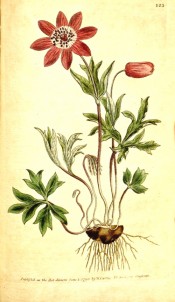Anemone hortensis L.
The type species is a low-growing, rhizomatous perennial with solitary mauve-pink flowers held above the finely-dissected leaves in spring. To 30cm. [RHSD, Hortus].
Horticultural & Botanical History
‘We are more and more convinced, that in our eagerness for novelties, we daily lose plants by far more ornamental than the new ones we introduce; the present, a most charming spring plant, with which the Gardens abounded in the time of Parkinson, is now a great rarity; its blossoms, which are uncommonly brilliant, come forth in April, and, like those of many other plants, appear to advantage only when the sun shines. […] Roots of a variety of this plant with scarlet double flowers are imported from Holland, under the name of Anemonoides, and sold at a high price.’ [BM t.123/1790]. ‘The Anemone hortensis […] has been sometimes called broad-leaved and coronaria narrow-leaved; but as cultivated varieties of these plants differ much in the form of their foliage and but little in that of their petals, the late Mr. Curtis thought it best to distinguish the former by the name of the Star Anemone and the latter by that of the Poppy Anemone, appellations by which the single kinds at least are best known in our gardens. In 1790, when our figure of Anemone hortensis was published, this plant was considered as a rarity, but it has since been much cultivated, and is now become very common. The same rage for novelty, which had nearly banished all the varieties of that species, has had considerable influence in diminishing the culture of the Poppy Anemone, although there is scarcely any plant that is capable of rendering the flower-garden so gay in the spring, especially if the season be favourable for its blowing.’ [BM t.841/1805]. The Gardeners Chronicle considered Anemone hortensis, A. stellata and A. coronaria, to be the progenitors of the [then] modern, florists’ anemone, with A. coronaria as the most important. [Gard Chron 1841]. Anemone hortensis was introduced from Italy in 1597. [JD].
History at Camden Park
Listed in the 1850 and 1857 catalogues only 1831 [B.40/1850]. It is probable that the plant listed in the catalogues as Anemone hortensis [i.e. ‘belonging to a garden’] represents the more decorative florists’ hybrids rather than the true species. This suspicion is perhaps given credence by the fact that ‘Anemones’ are recorded as received per the ‘Sovereign’ in February 1831. [MP A2948].
Notes
Florist’s anemone: ‘A fine flower should be two inches and a half in diameter; the exterior row of petals should be large and well rounded; the centre of the flower well filled up; the bloom of a hemispherical form; colours clear and distinct.’ [FC p.132/1855].
Published Jan 26, 2009 - 02:43 PM | Last updated Mar 05, 2010 - 09:26 AM
| Family | Ranunculaceae |
|---|---|
| Category | |
| Region of origin | Mediterranean |
| Synonyms |
|
| Common Name | Garden anemone |
| Name in the Camden Park Record | Anemone hortensis |
| Confidence level | medium |
